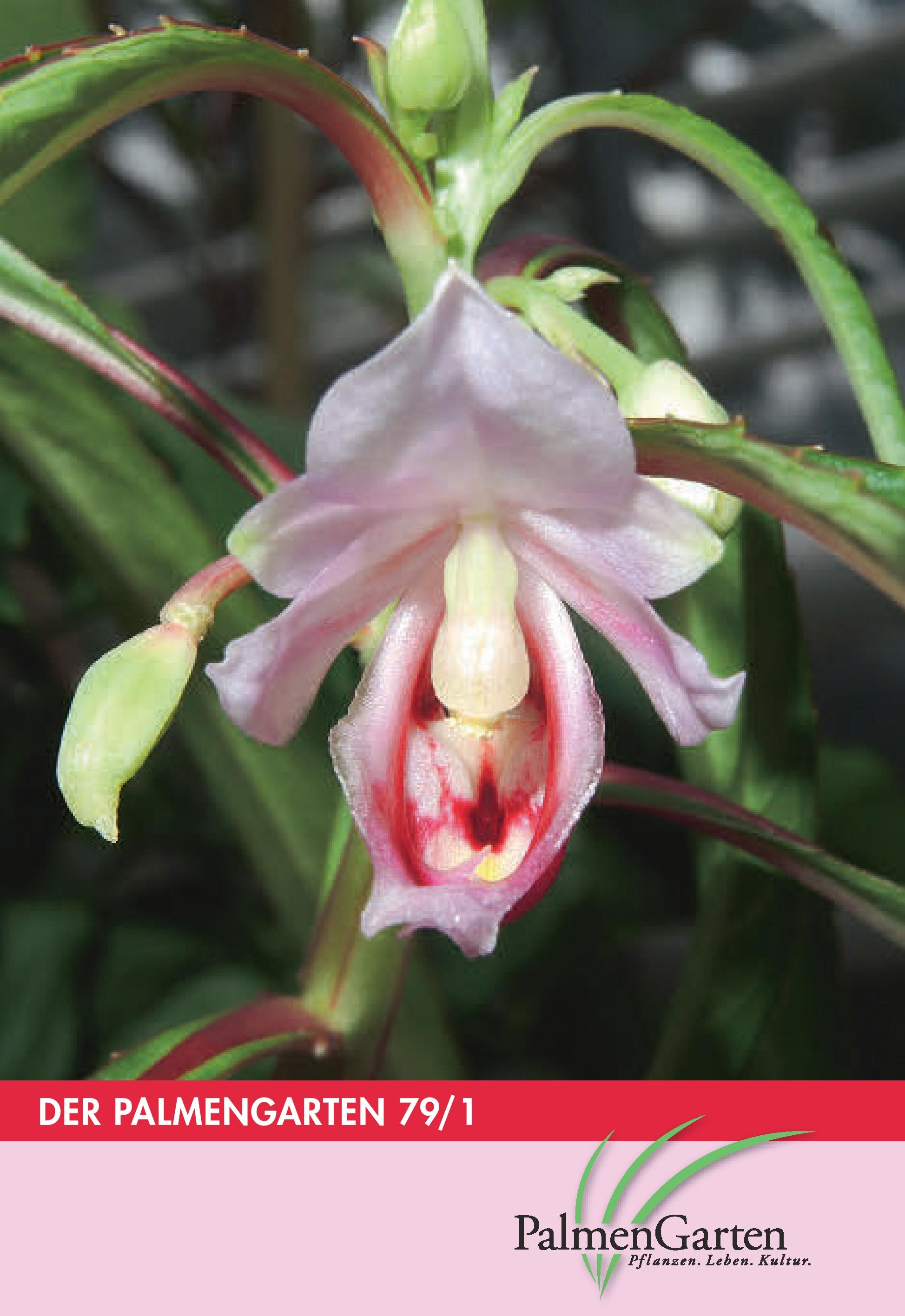Es stinkt! Komponenten im Blütenduft von Orchidantha fimbriata
DOI:
https://doi.org/10.21248/palmengarten.265Abstract
Im Dezember 2014 blühte im Ökologisch-Botanischen Garten der Universität Bayreuth Orchidantha fimbriata Holttum (Lowiaceae), deren bodennah stehende, große Blüten unangenehm, kotähnlich stinken. Dies war Anlass, Duftproben von einzelnen Blütenteilen (Labellum, Labellum plus Griffel-Staubblatt-Apparat, Sepalen) zu sammeln. Die Auswertung der Proben mittels Gaschromatographie gekoppelt mit Massenspektrometrie (GCMS) ergab, dass für die unangenehme Note des Duftes die Stoffe Dimethyldisulfid, p-Cresol sowie Indol verantwortlich sind. Diese Substanzen sind bereits aus anderen Kot oder Aasdüfte nachahmenden Pflanzenarten wie einigen Araceae und den Stapelien bekannt. Zudem enthielt das Duftbouquet neben einer großen Anzahl von Sesquiterpenen eine Reihe von Fettsäureestern, die dafür bekannt sind, Fruchtkäfer anzulocken.
Literaturhinweise
Dafni, A. 1984: Mimicry and deception in pollination. – Annu. Rev. Ecol. Syst. 15: 259–278. https://doi.org/10.1146/annurev.es.15.110184.001355
Faegri, K. & Pijl, L. van der 1979: The principles of pollination ecology. Third revised edition. – Oxford u. a.
Frost, S. K. & Frost, P. G. H …": Sunbird pollination of Strelitzia nicolai. – Oecologia 49: 379–384. https://doi.org/10.1007/bf00347603
Holttum, R. E. 1970: The genus Orchidantha (Lowiaceae). Garden’s Bulletin SXXV: 239–247.
Jenjittikul, T. & Larsen, K. 2002: Orchidantha foetida (Lowiaceae) a new species from Thailand. Nord. J. Bot. 22: 405–408. https://doi.org/10.1111/j.1756-1051.2002.tb01391.x
Johansen, L. B. 2005: Phylogeny of Orchidantha (Lowiaceae) and the Zingiberales based on six DNA Regions. Sys. Botany 30: 106–117. https://doi.org/10.1600/0363644053661931
Jürgens, A., Dötterl, S. & Meve, U. 2006: The chemical nature of fetid floral odours in stapeliads (Apocynaceae-Asclepiadoideae-Ceropegieae). New Phytol. 172: 452–468. https://doi.org/10.1111/j.1469-8137.2006.01845.x
Kite, G., Hetterscheid, W., Lewis, M., Boyce, P., Ollerton, J., Cocklin, E., Diaz, A. &, Simmonds, M. 1998: Inflorescence odours and pollinators of Arum and Amorphophallus (Araceae). In: Owens S. and Rudall P. (eds.): Reproductive biology in systematics, conservation and economic botany. – Kew.
Kress, W. J. 1990: The phylogeny and classification of the Zingiberales. – Ann. Missouri Bot. Gard. 77: 698–721. https://doi.org/10.2307/2399669
Larsen, K. 1961: A new species of Veratrum and Orchidantha fromThailand and Laos. – Sven. Bot. Tidskr. 56: 345–350.
Larsen, K. 1973: A new species of Orchidantha (Lowiaceae) from Vietnam. – Adansonia, ser. 2, 13: 481–482.
Larsen, K. 1993: A new species of Orchidantha (Lowiaceae) from Borneo. – Nord. J. Bot. 13: 285–288. https://doi.org/10.1111/j.1756-1051.1993.tb00050.x
Larsson, M. C., Stensmyr, M. C., Bice, S. B. & Hansson, B. S. 2003: Attractiveness of fruit and flower odorants detected by olfactory receptor neurons in the fruit chafer Pachnoda marginata. – J. Chem. Ecol. 29: 1253–1268.
Lev-Yadun, S., Ne’eman, G. & Shanas, U. 2009: A sheep in wolf’s clothing: do carrion and dung odours of flowers not only attract pollinators but also deter herbivores? – Bioessays 31: 84–88. https://doi.org/10.1002/bies.070191
Nagamasu, H. & Sakai, S. 1999: Orchidantha inouei (Lowiaceae), a new species from Borneo. – Nord. J. Bot. 19: 149–152. https://doi.org/10.1111/j.1756-1051.1999.tb00658.x
Pedersen, L. B. 2001: Four new species of Orchidantha (Lowiaceae) from Sabah. – Nord. J. Bot. 21: 121–128. https://doi.org/10.1111/j.1756-1051.2001.tb01346.x
Pedersen, L. B. & Johansen B. 2004: Anatomy of the unusual stigma in Orchidantha (Lowiaceae). – Am. J. Bot. 91: 299–305. https://doi.org/10.3732/ajb.91.3.299
Punekar, S. A. & Kumaran, K. P. N. 2009: Pollen morphology and pollination ecology of Amorphophallus species from north western Ghats and Konkan region of India. – Flora 205: 326–336. https://doi.org/10.1016/j.flora.2009.12.024
Renner, S. S. 2006: Rewardless flowers in the angiosperms and the role of insect cognition in their evolution. In: Waser N. M. & Ollerton J. (eds): Plant-pollinator interactions: From specialization to generalization. – Chicago.
Sakai, S. & Inoue, T. 1999: A new pollination system: Dung-beetle pollination discovered in Orchidantha inouei (Lowiaceae, Zingiberales) in Sarawak, Malaysia. – Am. J. Bot. 86: 56–61. https://doi.org/10.2307/2656954
Sakai S., Kato, M. & Inoue, T. 1999: Three pollination guilds and variation in floral characteristics of Bornean gingers (Zingiberaceae and Costaceae). – Am. J. Bot. 86: 646–658. https://doi.org/10.2307/2656573
Schiestl, F. P. & Dötterl, S. 2012: The evolution of floral scent and olfactory preferences in pollinators: Coevolution or pre-existing bias? – Evolution 66: 2042–2055. https://doi.org/10.1111/j.1558-5646.2012.01593.x
Shirasu, M., Fujioka, K., Kakishima, S., Nagai, S., Tomizawa, Y., Tsukay, H., Murata, J., Manome, Y. & Touhara, K. 2010: Chemical identity of a rotting animal-like odor emitted from the inflorescence of the titan arum (Amorphophallus titanum). – Biosci. Biotechnol. Biochem. 74: 2550–2554. https://doi.org/10.1271/bbb.100692
Stevens, P. F. 2001 onwards: Angiosperm phylogeny website. Version 12, http://www.mobot.org/MOBOT/research/APweb/, abgerufen am 29.3.2015.
Stiles, F. G. 1975: Ecology, flowering phenology and hummingbird pollination of some Costa Rican Heliconia species. – Ecology 56: 285–301. https://doi.org/10.2307/1934961




